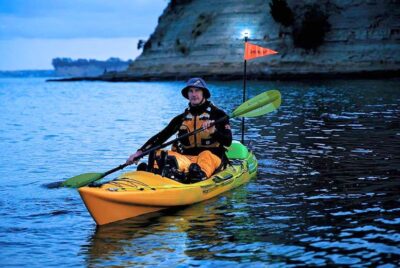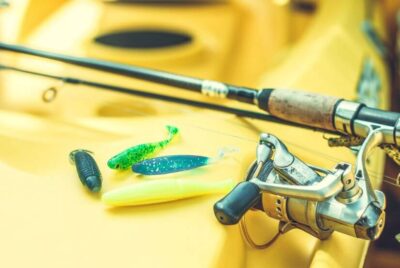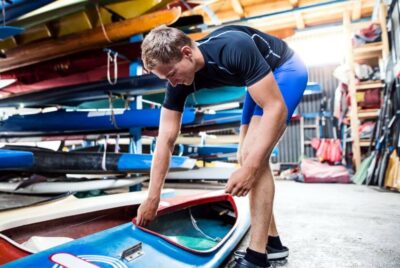An Essential Guide to a Kayak PFD for Beginners
Not the most popular, fun topic but one that is important when kayaking… safety! Safety should be your top priority. The main key to ensuring this? The right Kayak Personal Flotation Device (Kayak PFD) for your kayaking adventures.
Importance of Safety on the Water
The water, as serene and beautiful as it often appears, holds unpredictable elements. Every year, we hear of tragic incidents where novices and experienced enthusiasts face accidents due to overlooked safety precautions.
The absence of proper safety gear, especially a reliable personal flotation device (PFD), increases the risk of drowning and other water-related accidents.
Just as you wouldn’t drive without a seatbelt, you shouldn’t kayak without a PFD. It serves as your lifeline, ensuring you remain buoyant if you tip over or get caught in a tricky situation.
Beyond its practicality, wearing a PFD also provides mental assurance, allowing you to enjoy your time on the water with reduced fear. Safety on the water isn’t just about responding to accidents—it’s about preventing them. This proactive approach begins with understanding the importance of a kayak PFD.
What Exactly is a PFD (Personal Flotation Device)?
A Personal Flotation Device, often abbreviated as PFD, is a life-saving piece of equipment designed to keep the wearer buoyant and afloat in the water. At its core, the PFD’s primary function is to reduce the risk of drowning, making it an essential companion for anyone venturing into or near bodies of water.
But how does it achieve this?
- Buoyancy: PFDs are equipped with materials—commonly closed-cell foam or inflatable chambers—that provide positive buoyancy. This buoyancy counteracts the weight of the person, allowing them to remain on the water’s surface. In situations where someone accidentally falls into the water or gets submerged, the PFD ensures they rise and stay afloat.
- Design and Fit: Unlike regular vests or jackets, PFDs are specifically crafted to wrap securely around the wearer, ensuring they don’t slip off during a water incident. Their snug fit also ensures even buoyancy distribution, keeping the wearer in an upright or slightly backward-leaning position, which is crucial for keeping the airway clear.
- Versatility: PFDs come in various designs and forms to suit different water activities, be it kayaking, fishing, sailing, or even industrial work near water bodies. Some are designed for constant wear, while others, like throwable devices, are meant for quick assistance in emergencies.
- Additional Features: Modern PFDs often come equipped with added features for convenience and safety. This can include pockets for storing small items, loops for rescue lines, whistle attachments for signaling, or even reflective patches to increase visibility in low light.
Different Types of Personal Flotation Devices (PFDs)
When it comes to personal floatation devices, it’s not a one-size-fits-all scenario. Different PFDs serve various purposes, and depending on your kayaking activities, you’ll want to choose the type that suits you best. Here are the primary categories of PFDs you should be aware of:
- Type I: Offshore Life Jackets: These are designed for open, rough, or remote waters where rescue might take some time. They offer the most buoyancy and can turn most unconscious individuals face-up in the water. They’re a bit bulkier than other types, but their flotation ability is unmatched.
- Type II: Near-Shore Vests: Suitable for calmer waters and where a quick rescue is likely. They’re less bulky than Type I and can turn some unconscious wearers face up. However, they might not be as effective in turbulent waters.
- Type III: Floatation Aids: These are the most common types of water sports, including kayaking. They’re designed for conscious wearers in calm water, providing freedom of movement. While they might not turn an unconscious person face up, they’re comfortable and allow for a full range of motion.
- Type IV Throwable Devices: Not usually used when kayaking or paddleboarding. These aren’t worn but are meant to be thrown to someone in trouble. Examples include life rings and floating cushions. They’re a supplementary aid and shouldn’t replace wearable PFDs. These might come in handy if you’re kayaking with others (especially children or animals).

How does a Personal Floatation Device (PFD) work?
A Personal Flotation Device (kayak PFD) isn’t just a simple piece of gear; it’s a meticulously designed lifesaver that combines science, materials, and design to ensure you stay afloat in water. Let’s dive into the intricacies of its operation:
Material and Buoyancy
At the heart of every PFD’s functionality is the principle of buoyancy. This is a little technical for those that are into it here you go… buoyancy is the force exerted on an object submerged in fluid (in this case, water) that opposes the weight of the object. If the buoyant force is greater than the object’s weight, it floats. Whew, got that over.
The primary material used in PFDs to achieve buoyancy is foam, specifically closed-cell foam. This foam contains tiny pockets of gas (often air) that give it its buoyant properties. When you’re in the water, the foam’s buoyancy counteracts your weight, helping you stay afloat. Different types of PFDs might have varying amounts and distributions of foam, contributing to their specific performance characteristics.
Other PFDs, like inflatable types, rely on chambers filled with CO2 from gas cartridges. When activated, they rapidly fill with gas, providing buoyancy. The advantage here is the compact and lightweight design when not inflated, offering a comfortable fit without the bulk. (Kinda like the life vests they hold up on airplanes.)
Visibility and Color Choices
The effectiveness of a kayak PFD isn’t solely based on its buoyant properties. Visibility plays an equally crucial role, especially in emergencies. If you’ve ever wondered why many PFDs come in bright colors like orange, yellow, or neon green, it’s because these shades are easily noticeable against the blue or green backdrop of water.
Bright and fluorescent colors can be seen from a distance, making it easier for rescuers or other water-goers to spot someone wearing a PFD. Some PFDs also come with reflective patches or strips, which are beneficial during low-light conditions or nighttime. These reflective elements can catch the beam of a flashlight or searchlight, revealing the wearer’s location.
Furthermore, for those who prefer more muted or natural tones for aesthetic or recreational purposes, it’s essential to ensure the PFD has at least some bright or reflective elements. That way, you can enjoy the best of both worlds: style and safety. And who doesn’t like to look stylish?
Sizing Your PFD
Getting the right size for your PFD is crucial, not just for comfort but, for safety. A poorly fitted life jacket might not provide the necessary buoyancy in critical situations, or it could even slip off entirely. Let’s look at how to get the perfect fit:
Know Your Weight and Chest Size: Different life jackets are designed for varying weight ranges and chest sizes. Before shopping, measure your chest circumference at its widest point, typically just under the arms and above the chest. This measurement is often more critical than weight for a snug fit.
Try Before You Buy: If possible, wear the life jacket and adjust all straps and closures. It should feel snug but not overly tight. Raise your arms overhead; the jacket should stay in place and not ride up significantly.
Check the Fit: While wearing the life jacket, ask someone to pull it up by the shoulders. If it moves excessively, revealing your stomach or lower ribs, it’s too large. Conversely, if you can’t fasten it or feel constricted breathing, it’s too small.
Consider Activity-Specific Designs: Some PFDs are tailored for specific activities. For instance, kayaking PFDs might have broader armholes for easier paddling, while fishing PFDs might come with multiple pockets. Ensure your choice aligns with your intended use.
Children’s Sizing: Always buy children’s life jackets based on weight rather than age. Children’s PFDs are specifically designed to offer the right buoyancy and fit for smaller bodies. Never let children wear adult-sized jackets, assuming they’ll “grow into it.”
Recheck Periodically: Bodies change over time. What fit perfectly a few years ago might not fit as well today. Regularly checking the fit ensures that your PFD remains effective and safe.
Remember, a life jacket’s primary function is safety. Even the most advanced, feature-rich PFD can’t protect you if it doesn’t fit correctly. Always prioritize size and fit above aesthetics or added features.
Best Practices for Using and Maintaining a PFD
Like all gear, your PFD requires regular attention and care to ensure it remains in optimal condition. After all, a well-maintained PFD is more likely to perform for you when you need it most.
Checking for Wear and Tear
Regular inspections of your PFD are super important. Here’s a checklist for you:
- Straps and Fastenings: Ensure that all straps, zippers, and buckles are intact and function correctly. Broken or frayed straps can compromise the fit and security of the PFD.
- Foam and Inflation: For foam-based PFDs, check for any compressed areas, which might indicate reduced buoyancy. (Don’t set heavy things on top of your vest!) For inflatable PFDs, test the inflation mechanism periodically and ensure CO2 cartridges are full and properly seated.
- Surface Damage: Examine the outer shell for rips, tears, or punctures. Even minor damage can lead to significant water intake, affecting the buoyancy. It’s good to fix them with some clothing glue or fray check when it just begins to help it last longer.
- Stitching: Check for any loose or broken stitching, especially around stress points like shoulder areas.
- Overall Integrity: Give your PFD a gentle tug and pull in different areas to mimic the forces of water. This action can reveal hidden weaknesses or issues not immediately visible.
Cleaning and Storing Your Personal Flotation Device
A clean PFD isn’t just about aesthetics; it’s about preserving its material integrity. Here’s how you can keep it in tip-top shape:
- Cleaning: Use mild soap and fresh water to clean your PFD. Avoid harsh detergents or chemicals, which can degrade the materials. Rinse thoroughly to remove all soap residues.
- Drying: Always air-dry your PFD away from direct sunlight. UV rays can weaken the fabric and reduce its lifespan. Ensure it’s fully dried before storing to prevent mold or mildew growth.
- Storage: Store your PFD in a cool, dry place. As I mentioned above, avoid stacking heavy items on top of it, as this can compress the foam and reduce buoyancy over time. For inflatable PFDs, keep them away from sharp objects that might puncture the inflation chambers.
- Regular Air-outs: If stored for long periods, take your kayak PFD out occasionally to air it, ensuring it remains fresh and ready for use. No one enjoys the stale smell clothes have when you haven’t pulled them out of the closet for awhile – same for PFDs.

Conclusion
Embarking on a kayaking journey is a wonderful, fantastic experience that everyone should enjoy at least once in their life. However, like all ventures into nature’s realms (and all realms, let’s be honest), it comes with inherent risks. By understanding the importance of a PFD and ensuring its proper maintenance, you equip yourself with a guardian angel when you’re on the waves. As you paddle forward, get the safety in place with your trusted PFD so you can create memories that fill your heart. Safe paddling!
FAQs
Q: What’s the difference between a life jacket and a PFD?
A: While both are designed for safety, a life jacket is specifically crafted to turn an unconscious person face up in the water, ensuring their airways stay clear. PFDs, or Personal Flotation Devices, may not have this feature but offer more comfort and mobility, making them popular for activities like kayaking where users are conscious and need to move freely.
Q: Can I use an inflatable PFD for all water sports?
A: Inflatable PFDs are lightweight and comfortable but might not be suitable for high-impact sports or situations where quick immersion is possible. They’re best suited for experienced swimmers in calm waters. Always check the label to ensure it’s approved for your intended activity.
Q: How often should I inspect my PFD?
A: It’s a good practice to inspect your kayak PFD before each use, checking for visible damages and ensuring all fastenings work. A more thorough inspection, like checking for foam compression or internal wear, should be done at least annually or after any significant impact or prolonged use.
Q: Are there any PFD options for pets?
A: Yes, there are specially designed PFDs for pets, particularly dogs. If you’re planning on bringing your furry friend on your water adventures, ensure they have a well-fitted PFD to keep them safe. These often come with handle grips, allowing you to lift or guide your pet easily.
Q: Do PFDs expire?
A: While PFDs don’t have a strict “expiration date,” their effectiveness can diminish over time due to wear and tear, UV damage, or material degradation. It’s essential to regularly inspect and replace them when signs of wear become evident or if they no longer maintain buoyancy effectively.





